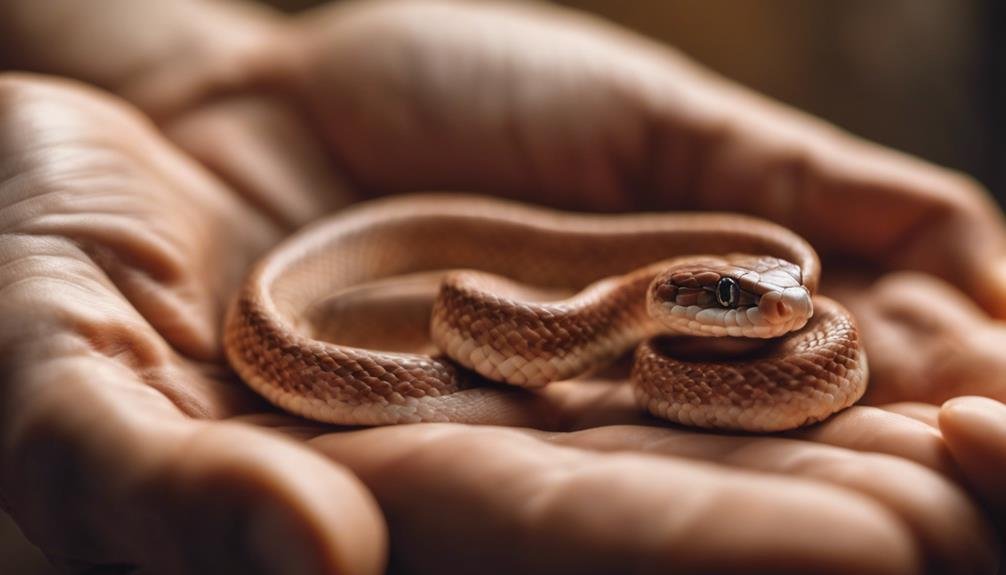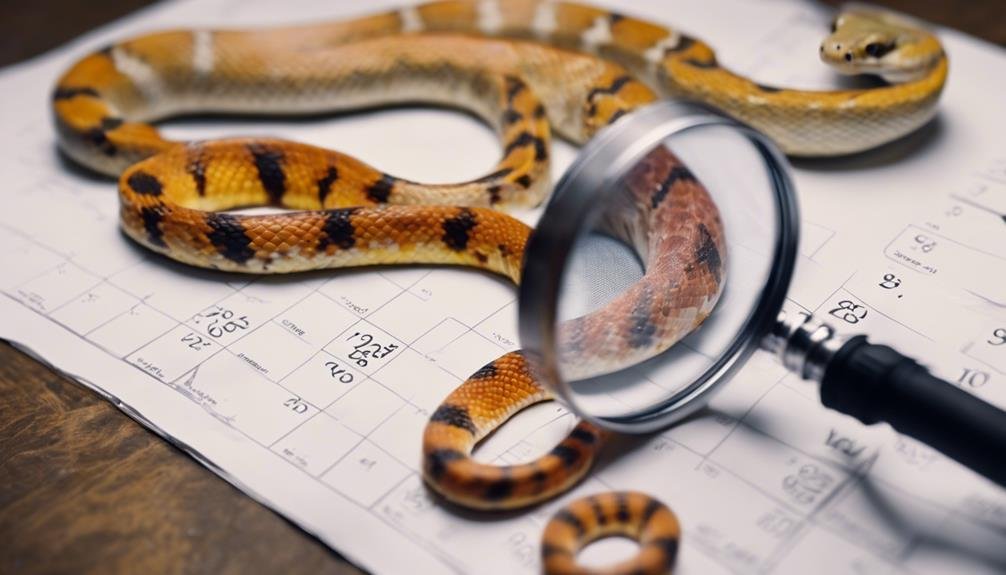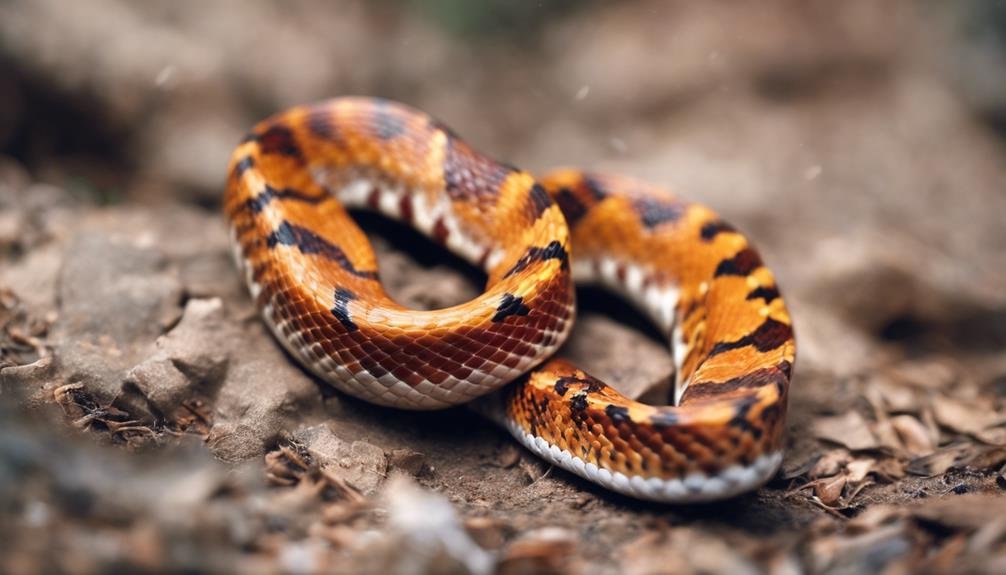If you’ve noticed your corn snake shedding its skin more frequently than usual, it’s important to understand that this could indicate several underlying issues. There are many factors to consider, from inadequate humidity levels in their enclosure to potential nutritional deficiencies or even health concerns. Addressing these concerns promptly can greatly impact your snake’s health and well-being. As we examine causes and provide recommendations to prevent excessive shedding, you’ll uncover valuable insights that can help guarantee your corn snake remains healthy and happy. Stay tuned to find how simple adjustments in care can make a difference.
Key Takeaways
- Excessive shedding in corn snakes may indicate health issues or improper habitat conditions.
- Maintaining ideal humidity levels is crucial to prevent frequent shedding.
- A balanced diet and proper nutrition help regulate shedding cycles and prevent excessive shedding.
- Regular habitat maintenance and monitoring are essential to ensure a healthy shedding process.
- Consulting a reptile veterinarian can provide tailored advice and address the underlying causes of frequent shedding.
Understanding Corn Snake Shedding
Shedding, an essential process for corn snakes, allows them to grow and adapt to changes in their body size. As a corn snake owner, it’s important to understand that shedding is a regular part of your snake’s life cycle. Younger snakes, including hatchlings and juveniles, tend to shed more frequently, every 4-6 weeks, due to their rapid growth. In contrast, adult corn snakes shed every three months, reflecting slower growth rates.
Proper care during shedding is vital for your snake’s health. Ensuring the right humidity and hydration levels in the enclosure facilitates smooth shedding. Your snake might experience difficulties without adequate moisture, leading to partial sheds or discomfort. Monitoring your snake after it has shed is essential; paying close attention to the eye caps and tail tip can help identify any issues early on. If you notice any stuck shed, addressing it promptly with a warm bath or providing a humid hide can prevent potential complications.
Signs of Excessive Shedding
If your corn snake is shedding more often than usual, it may indicate underlying health issues or environmental stressors. The critical shedding cycle can be disrupted, leading to frequent episodes that could signal something amiss. You’ll notice signs that are hard to miss, such as dull scales that lack their usual luster, eyes that turn cloudy or milky, indicating a shed is imminent, and sagging skin under the chin that seems out of the ordinary. Additionally, if your snake is showing lethargy or hiding more than usual, it’s time to pay attention.
Repeated shedding isn’t just an odd quirk; it may suggest unresolved skin problems or deeper underlying health concerns that need addressing. That’s why closely monitoring your corn snake’s shedding patterns is essential. Observing these patterns can help you identify when the frequency becomes excessive and when action is needed.
Adopting proper husbandry practices is vital in managing your snake’s health and can greatly reduce stress-induced shedding. Ensuring your corn snake’s environment is ideal, with the right humidity and temperature, can help stabilize the shedding frequency and keep your slithery friend healthy and happy.
Common Causes of Frequent Shedding
If your corn snake is shedding too often, it’s important to consider the underlying causes. Inadequate humidity levels, nutritional deficiencies, and various health and stress factors are common culprits.
Addressing these issues can improve your snake’s shedding cycle and overall well-being.
Inadequa wellbeing
Maintaining the right humidity level for corn snakes is critical to prevent frequent shedding. When humidity levels drop too low, it can lead to dehydration and skin issues, making your snake shed more often than is healthy
To keep your corn snake’s environment ideal for shedding, consider the following actions:
- Monitor the habitat’s humidity levels regularly.
- Increase misting frequency to boost humidity.
- Provide a humid hide in the enclosure.
- Adjust the ambient humidity using a room humidifier if necessary.
Nutritional Deficiencies
Nutritional deficiencies stemming from a lack of essential vitamins and minerals can lead to your corn snake shedding more frequently than normal. When their diet isn’t up to par, whether due to inadequate food choices or improper supplementation, it doesn’t just affect their growth or weight; it hits their skin health directly.
These deficiencies can trigger issues within the skin, disrupting the natural shedding cycle and leading to more frequent shedding episodes. By ensuring your corn snake’s diet is rich and balanced, supplemented with the right vitamins and minerals, you’re not just feeding them; you’re nurturing their skin’s health and stability.
If you’re unsure about their nutritional needs, don’t hesitate to consult a veterinarian or reptile specialist. They can guide you in correcting any deficiencies, helping to normalize shedding frequency.
Health and Stress Factors
Beyond nutritional issues, various health and stress factors, including injuries, parasites, and poor husbandry, can lead to your corn snake shedding too often, and recognizing the signs of shedding more frequently than the normal cycle can indicate underlying health problems that need your attention.
To guarantee your corn snake remains healthy and its shedding cycle stays regular, consider the following:
- Regularly check for mites and injuries, as these can prompt excessive shedding.
- Maintain ideal husbandry conditions to prevent stress-related health issues.
- Apply 100% Aloe vera on damaged skin areas to support healing.
- Consider reptile or bird vitamins, avoiding human vitamins due to metabolic differences.
Managing these aspects diligently can help mitigate frequent shedding and keep your corn snake healthy.
Monitoring Shedding Frequency
Keeping an eye on how often your corn snake sheds is crucial for maintaining its health and well-being. Typicallwewewellbeingheir skin to allow for growth and to remove parasites. A healthy corn snake might shed every 4-6 weeks, but this frequency can vary greatly depending on the snake’s age and specific health conditions. Understanding that too frequent and infrequent shedding can indicate a health issue is vital.
When monitoring your snake’s shedding frequency, note that healthy snakes should shed in one complete piece over 7-14 days. If you observe that the shedding process is taking longer, or if your snake is shedding in patches rather than one complete piece, this could signal husbandry issues such as improper humidity or temperature levels within their habitat.
Proper care and adjustments based on observations can help ensure your snake sheds completely and remains healthy. Monitoring shedding patterns isn’t just about keeping track of how often it happens but also involves observing the quality of each shed. Incomplete shedding, for instance, is a clear sign that your snake might need a bit more attention to its living conditions to thrive.
Preventing Excessive Shedding
Focus on key areas to prevent your corn snake from shedding too often.
Ensuring the habitat’s humidity is ideal and the diet is nutritious are crucial steps.
Maintaining their living space also plays an important role in keeping their shedding cycle normal.
Optimal Humidity Levels
Maintaining your corn snake’s habitat at an ideal humidity level of 40% to 60% is crucial to prevent excessive shedding and skin issues. Straying from these ideal humidity levels can cause a slew of problems for your slithery friend.
- A quality hygrometer will be used to accurately monitor the humidity levels within the enclosure.
- Remember, low humidity can lead to dehydration and more frequent shedding.
- Conversely, high humidity levels above 60% might result in respiratory infections, which are tricky to manage.
- Maintaining balance ensures your corn snake remains healthy and sheds its skin properly.
Diet and Nutrition
Ensuring your corn snake receives a balanced diet with the right nutritional content is vital for preventing excessive shedding. Proper nutrition is essential in maintaining your snake’s health and can greatly influence shedding cycles. It’s important to carefully monitor your snake’s feeding schedule and adjust it to avoid any nutritional deficiencies that could trigger more frequent shedding.
Consult a reptile veterinarian to tailor a diet plan for your corn snake’s unique needs. This plan should include necessary supplements like calcium and vitamin D3, guaranteeing healthy shedding and overall well-being.
| Key Compwelwelwellbeing | |
|---|---|
| anced Diet Plan | Regulates shedding cycles |
| Nutritional Content | Prevents deficiencies leading to excessive shedding |
| Supplements | Supports overall health and normal shedding |
Regular Habitat Maintenance
Regularly cleaning and adjusting your corn snake’s habitat is critical in preventing excessive shedding. As your snake grows, it’ll shed its skin regularly. To make sure this process is healthy and not overly frequent, consider the following:
- Monitor and maintain the proper humidity levels in the enclosure to facilitate easy shedding.
- Maintain the enclosure regularly to prevent skin infections that complicate the shedding process.
- Choose a substrate that retains moisture well, supporting a humid environment that aids in shedding.
- Guarantee adequate ventilation to prevent excess moisture buildup, which can lead to other health issues.
Consulting a Veterinarian
Seeking a veterinarian’s advice is vital when your corn snake starts shedding more frequently than usual. Veterinarians are trained to diagnose and treat health issues related to shedding in corn snakes. By consulting a veterinarian, you’ll receive specific guidance tailored to your individual snake’s needs. This professional input can be invaluable, as it’s not just about addressing the symptoms but getting to the root cause of the shedding issues.
Veterinarians can recommend treatment options and adjustments to husbandry practices that might contribute to the problem. These adjustments are designed to address the immediate issue and promote your child’s long-term health and well-being—exams through nations, vets, and veterinarians identifying causes of frequent shedding, which might be missed without their expertise.
It is important to understand that shedding problems can be a sign of underlying health issues. Therefore, seeking veterinary advice isn’t just about tackling the shedding but also about ensuring that your corn snake leads a healthy, happy life. Consulting a veterinarian early on can prevent minor issues from becoming major problems, keeping your slithery friend in the best possible shape.
Handling During Shedding


It’s best to avoid handling your corn snake during shedding to minimize discomfort and potential stress. The shedding process is critical for your snake, and proper snake care involves guaranteeing its comfort and health. Handling it during this period can’t only cause it pain but also disrupt the natural shedding process, possibly leading to complications that could affect its well-being.
To guarantee well-being through a smooth shedding process, consider the following recommendations:
- Wait until shedding is complete before interacting with your snake. This patience allows them to shed their skin without interference, promoting a healthy and complete shedding cycle.
- Maintain proper habitat conditions, including humidity levels and hydration, to support the shedding process. A well-maintained environment is essential for facilitating an easy shed.
- Monitor the shedding process without direct handling. Observing from a distance allows you to check progress while minimizing your snake’s stress.
- Reduce loud noises and sudden movements around the snake’s habitat to create a stress-free environment, ensuring a successful shedding process.
Addressing Shedding Issues
If your corn snake is shedding too frequently, it’s important to identify and address the underlying causes to guarantee their health and well-being. Shedding and well-being are affected by various factors, including injuries, parasites, allergies, mites, or poor husbandry conditions. By tackling these issues head-on, you’ll ensure your snake’s skin health remains at its best.
To manage shedding issues effectively:
| Cause | Solution | Benefits for Skin Health |
|---|---|---|
| Mites & Injuries | Check and treat with vet-approved methods | Prevents further skin damage |
| Poor Husbandry | Improve habitat conditions | Ensures a healthy shedding cycle |
| Nutritional Deficits | Use liquid bird vitamins with caution | Promotes overall skin health |
Ensuring your snake’s habitat is clean and at the right humidity and temperature is important for preventing frequent shedding. Additionally, supplementing their diet with specific vitamins, particularly liquid vitamins designed for birds, can support skin health and normal shedding patterns. Remember, if shedding issues persist, it’s crucial to consult with a vet to rule out any underlying health concerns. Monitoring your snake’s shedding frequency and maintaining a suitable environment are key steps in addressing and preventing future shedding problems.
Is Corn Snake Hibernation Related to Their Shedding Patterns?
Yes, the reasons for corn snake hibernation are related to their shedding patterns. The decrease in temperature during hibernation slows down their metabolism, which in turn slows down the shedding process. Once they emerge from hibernation, they shed their old skin to accommodate their new growth.
Conclusion
If you notice your corn snake shedding too often, acting promptly is important. Ensure that their habitat has the right humidity and that they get a balanced diet.
Keep an eye on shedding patterns, and don’t hesitate to consult a vet if things seem off. Remember, gentle handling during shedding periods can make a big difference.
Addressing these issues will help your slithery friend maintain a healthy shedding cycle and overall well-being.
Related Article
https://thereptileguide.com/tail-rot-bearded-dragon/
https://thereptileguide.com/chameleon-facts/



